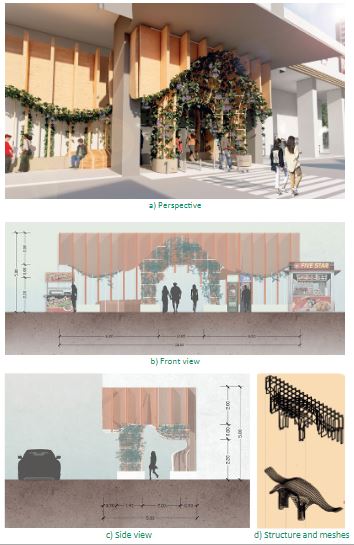Study of PM2.5 Filtering by Using Climbing Plant Attached to an Architecture
Keywords:
Air pollution, Particulate matters, Particulate filtering, Leaf densityAbstract
Presently, PM 2.5 (Particulate Matter up to 2.5 micrometers in size) causes health problems and affects human daily life. Previous studies found that some plants help to filter fine particles by trapping dust and particulate matters on their leaves, which can be washed for reuse. This research aims to use the leaves of the Bengal trumpet plant (Thunbergia grandiflora.) adhering to a design architecture to reduce the amount of PM2.5 flowing into buildings. The Bengal trumpet attached to the wire-mesh architecture located in front of the building’s door traps PM 2.5 on its leaves. The architecture obstructs the high flowing wind through the door. Research methods include PM 2.5 filtering in the test box, and wind resistance design to reduce wind speed using the Flow Design program. The results showed that Bengal trumpet leaves with a density of 85 leaves per 0.4 square meters could reduce PM2.5 up to 60%. The results of simulation with the Flow design program showed that wire-mesh architecture with half-cylinder form reduces wind speed more than that of cylinder forms for a similar surface area. This research confirms previous findings that plant leaves can trap fine particles. Furthermore, an architecture designed to moderate wind speed in appropriate direction with Bengal trumpet leaves can increase the filtering performance significantly.
Downloads
References
Amann, M., Cofala, J., Heyes, C., Klimont, Z., Mechler, R., Posch, M., & Scho ̈pp W. (2004). The RAINS Model. Documentation of the Model Approach Prepared for the RAINS Review. Laxenburg, Austria: International Institute for Applied Systems Analysis (IIASA).
Amanna, M., Bertoka, I., Borken-Kleefelda, J., Cofalaa, J., Heyesa, C., Ho ̈glund-Isaksson, L., et al. (2011). Cost- effective control of air quality and greenhouse gases in Europe: Modeling and policy applications. Environmental Modelling & Software, 26, 1489–1501.
Chen, Y., Wild, O., Ryan, E., Sahu, S. K., Lowe, D., Archer- Nicholls, S., Wang, Y., McFiggans, G., Ansari, T., Singh, V., Sokhi, R. S., Archibald, A., and Beig, G. (2019). Mitigation of PM2.5 and Ozone Pollution in Delhi: A Sensitivity Study during the Pre-monsoon period. Atmospheric Chemistry and Physics (ACP), 28p.
Chuersuwan, N., Nimrat, S., Lekphet, S., Kerdkumrai, T. (2008). Levels and major sources of PM2.5 and PM10 in Bangkok Metropolitan Region. Environment International, 34(5), 671-7.
de Jalón S.G., Burgess P.J, Yuste J.C., Moreno G., Graves A., Palma J.H.N, Crous-Duran J, Kay S, Chiabai A. (2019). Dry deposition of air pollutants on trees at regional scale: A case study in the Basque Country. Agricultural and Forest Meteorology, 278, 107648.
Department of Land Transport. (2019, October 4). Urgent measures to solve the PM 2.5 problem. Retrieved from Public News: https://www.dlt.go.th/th/public-news/view.php?_did=2403
Guha, A. (2008). Transport and Deposition of Particles in Turbulent and Laminar Flow. Annual Review of Fluid Mechanics, 311-341.
Kunugi, Y., Arimura, T.H., Iwata K.,, Komatsu, E., Hirayama, Y. (2018). Cost-efficient strategy for reducing PM 2.5 levels in the Tokyo metropolitan area: An integrated approach with air quality and economic models. PLoS ONE, 13(11), e0207623.
Pacyna, J.M. . (2008). Atmospheric Deposition. In J. Pacyna,Encyclopedia of Ecology. Maryland, USA: Elsevier B.V.
Pope CA 3rd, Burnett RT, Thun MJ, Calle EE, Krewski D, Ito K & Thurston GD. (2002). Lung cancer, cardiopulmonary mortality, and long-term exposure to fine particulate air pollution. Journal of the American Medical Association, 287(9):, 1132-41.
Rattanapun, T., Ongwandee, M., Panyametheekul, S. (2017). Assessment of the Ability of Houseplants to Trap Indoor Particulate Matter. Engineering Journal Chiang Mai University, 69-80.
Sehmel, G.A. (1972). PARTICLE EDDY DIFFUSIVITIES AND DEPOSITION VELOCITIES FOR SMOOTH SURFACES. Wahington: BATFELLE, Pasific Northwest Laboratories.
Shannigrahi, AS., Fukushima, T., Ozaki, N. (2005). Comparison of different methods for measuring dry deposition fluxes of particulate matter and polycyclic aromatic hydrocarbons (PAHs) in the ambient air. Atmospheric Environment, 39, 653-662.
Sun, F., Yin, Z., Lun, X., Zhao, Y., Li, R., Shi, F., Yu, X. (2014). Deposition Velocity of PM2.5 in the Winter and Spring above Deciduous and Coniferous Forests in Beijing, China. PLOS ONE, e97723.
Sunakorn, P., Tapornpasi, O., Boonkorkaew, P. (2016). Comparision of the Ability to Capture Airbourne Dusts of Climbing Plants. ARCH KKU JOURNAL, 175-186.
Wu, Y., Liu, J., Zhai, J., Cong, L., Wang, Y., Ma, W. (2018). Comparison of dry and wet deposition of particulate matter in near-surface waters during summer. PLoS ONE, 13(6), e0199241.
Yina, S., Zhang, X., Yu, A., Sun, N., Lyu, J., Zhu, P., Liu, C. (2019). Determining PM2.5 dry deposition velocity onplant leaves: An indirect experimental method. Urban Forestry & Urban Greening, 46, 126467.
Zhu, R., Zhang, Y., Yuan, Y., Li, S. (2018). Deposition Loss of Particles in the Sampling Lines of continuous Emission Monitoring System (CEMS) in Coal-fired Power Plants. Aerosol and Air Quality Research, 18, 1483–1492.

Downloads
Published
How to Cite
Issue
Section
License
Copyright (c) 2020 International Journal of Building, Urban, Interior and Landscape Technology (BUILT)

This work is licensed under a Creative Commons Attribution-NonCommercial-NoDerivatives 4.0 International License.











